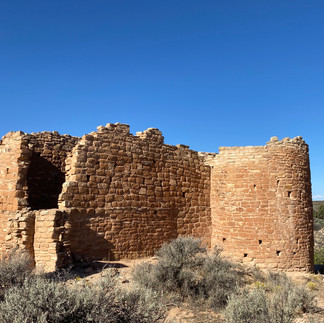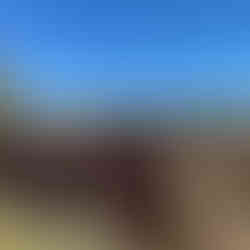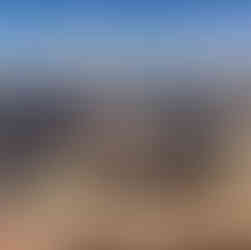Monday I took a day trip from Moab south toward Four Corners.
My first target was Hovenweep National Monument about 3 hours due south from Moab, it sits right next to the Colorado border. The area is remote and roads are not all paved. I shared the roads going into the site with free range cattle, horses and a herd of sheep being mustered by a native woman on a Kawasaki motor bike. The National Park Service maintains this area where six villages were built by Ancestral Puebloans withing the cliff rims and walls of Hovenweep (deserted valley).
The structures were built between AD 1200-1300 and housed 100-150 people in each village. There were grain storage buildings, ceremonial structures and intricate checkdams to slow water during flash floods or protect plantings from erosion. The buildings had small chink windows which gave them the look of fortresses. The purpose of those portals is not known - defense? ventilation? ceremonial astronomy?
It was well over 90 degrees and bone dry on the mesa top the morning I visited. It was hard to imagine planting, protecting and harvesting enough crops to feed any people in that climate. The current thought is that weather stress (indicated by the tree ring record) drove these ancestral people to move southward in search of better farming conditions. Regardless, by AD 1300 they were all gone, so no one can answer all our questions.
I was very impressed with the solidity of the building - in a climate where e-v-e-r-y-t-h-i-n-g breaks down to sand, these structures were holding solid. But I was most impressed with how peaceful it was there - not a lot of park visitors and no other noise but the occasional puff of wind. On the way out of the site a coyote trotted across the road in front of me and didn't even bother to look back.
My second target was Goosenecks State Park west and south of Hovenweep, on the edge of Navajo lands. Here the San Juan River literally winds its way toward Lake Powell in long ribbony sweeps called goosenecks. In this section the river travels 6 miles by water to cover 1 mile as the crow flies. The river has been at it for a while, because the canyon floor is 1,100 feet down - now that's a river that had some time on its hands. It made me think of my avid teenaged consumption of Edward Abbey books: “Men come and go, cities rise and fall, whole civilizations appear and disappear-the earth remains... and only rock is real. Rock and sun.” Back to Moab for sunset I hope.
























Wow, beautiful photos!!!